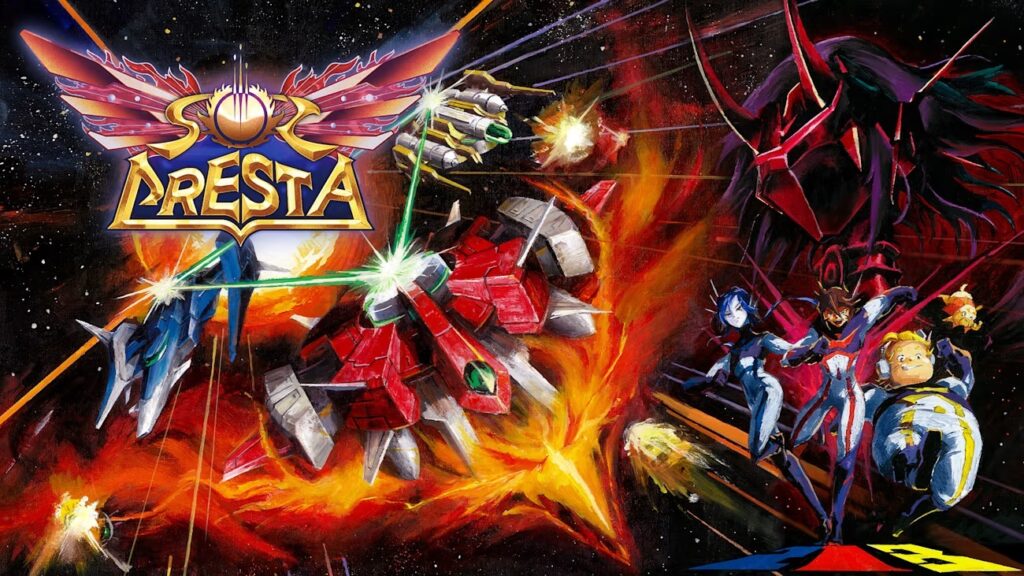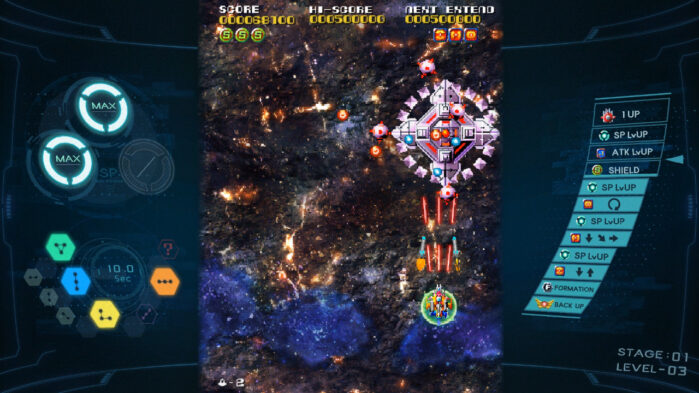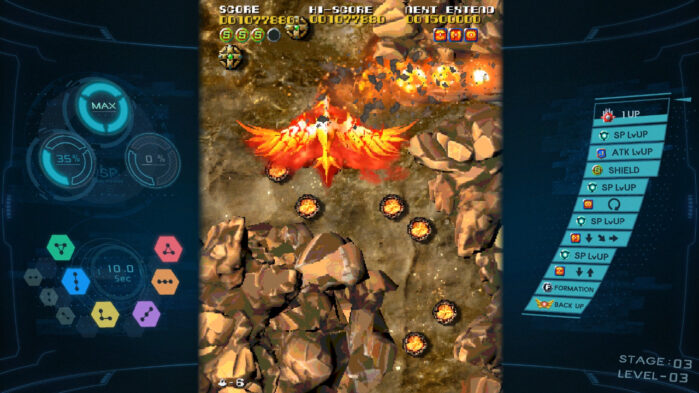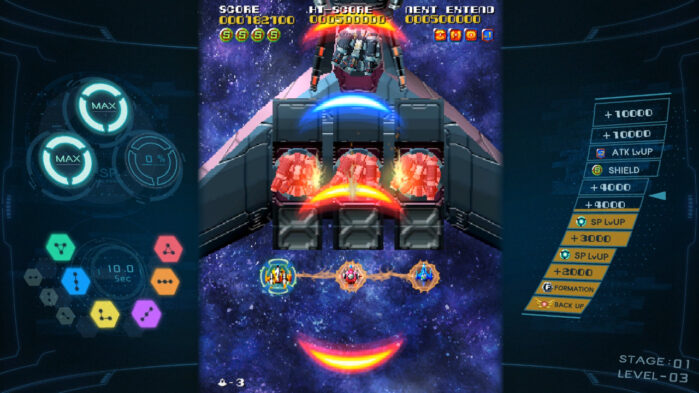
The Terra Cresta series is a well-regarded series of shmups from Nichibutsu that began with Moon Cresta way back in 1980. After multiple sequels including the various Terra Cresta entries, the series seemed to fade away along with the end of the arcade era. Now PlatinumGames has begun its Neo Arcade series with a new entry in the Cresta franchise entitled Sol Cresta which picks up right where the last game left off.
Sol Cresta is a game with a deep learning curve which can be compared to a fighting game insomuch as you need to learn movements and combos in order to succeed. The game uses two-button controls for autofire, shoot and auto change but the firepower available is dependent on your ship order. For some players, it might be best to think of the controls as similar to fighting game inputs, and even the scoring in Sol Cresta is based on the ship order, prioritizing the need to understand formations.

Sol Cresta sees you take control of three ships, which combine to generate different shot types and formations. Shot type is determined by the top ship, while the middle ship will alter your charge shot. Different shot types work against different enemies, so you will need to carefully strategize to succeed.
Formations are the key to success in Sol Cresta and there are multiple formations that can be collected as you go on. This is important because it enables access to a flaming Phoenix attack which is very useful against powerful enemies and bosses but tricky to access. This may sound like a lot to remember, but don’t worry, the more you play, the more it will become second nature to you.

In addition to formations, you also have to watch the Sol Gauge which acts as the power meter for your ships. The gauge gains strength as you take on enemies and eventually provides new abilities, combos, and techniques as it is filled. The gauge has other gameplay bonuses as well, such as extra lives which are granted for completion, boosts to speed, shields, and more.
Sol Cresta is one of those games that is difficult to master but feels rewarding when you do. Despite the steep learning curve, the game is also rather generous with the damage and shield system. Taking hits may cost you on the Sol Gauge but shield icons are quite common and the powerups are fairly frequent as well. Finally, Sol Cresta has excellent auto fire mechanics, allowing you to charge shots while holding down autofire. This dual function attack is a significant improvement from similar shmups.
Sol Cresta demands you constantly improve while throwing some very hectic bullet hell segments and later on, even suicide bullets at you. As you try and take on enemies, dodge attacks, and keep formations changing, the risk-reward design of the gameplay comes together and you’ll begin to find the right formations for each situation. While this all sounds challenging, the difficulty can also be changed on the fly, making the game more accessible for all.

Another interesting feature of Sol Cresta is that the game does not use a traditional continue system, instead replacing it with a stage progress system that replaces continues. This is superior to regular continues as it allows you to restart at a stage of their when you run out of lives. Regardless of whether you just want to practice an area and spend more time there or would like to start from where you died on your last playthrough, this is a useful function.
For all the positives, there are a few negatives with Sol Cresta as well. The soundtrack by Yuzo Koshiro is outstanding and it is truly some of his best work, but the audio is only half of the presentation. There is simply no other way to say it: Sol Cresta is ugly. The game attempts to go for a vintage 2D pixel art look but comes off flat and dull rather than sporting a vintage retro look. In fact, Sol Cresta isn’t even properly optimized for 1080P on the Switch and setting your system to 720P actually improves the jarring visuals in the game.
On top of the rough visuals, there are gameplay issues as well. Sol Cresta has multiple performance issues when playing on the Nintendo Switch, including 9 frames of input delay as well as slowdown, pauses and framerate issues that are not present in the PC version of the game. Sol Cresta does actually runs better on the Switch if played in TATE mode (vertical mode) though, running around 4 frames faster in this mode and making a notable difference.

It should also be noted that this is a long game and some levels can feel like they are dragging on interminably. If you use the dramatic mode DLC, you gain access to the story mode of the game which explains the background of the plot but increases the length of both levels and the overall campaign as well. All voiceovers in this mode are in Japanese, but the text is in English and the stages are laid out differently to fit the story, expanding the length of the levels. The DLC does add a lot to the main game but the lack of localized voice acting is disappointing and trying to read the story while playing can be somewhat distracting.
That classic PlatinumGames charm is still here though, and the music by Yuzo Koshiro is simply outstanding. Each stage has an excellent musical score that manages to fit the gameplay perfectly. If Sol Cresta had been given a bit more polish in development, PlatinumGames might have had a smash hit on their hands. Instead, the game feels like it is just a few months away from going gold even after its release.
If you are a fan of classic shooters, bullet hell shmups, or unique inputs in your shmups, Sol Cresta will likely appeal to you. The game could use some functionality patches on Switch though, even if the PC version is significantly more stable. Sol Cresta is a fun game that just needs a bit more tweaking to become an enduring classic, so let’s hope PlatinumGames steps up and fixes a few things because beneath that rough exterior is an excellent game!
Disclaimer: A review key was provided
Reviewed on Nintendo Switch & PC
Also available on PlayStation

